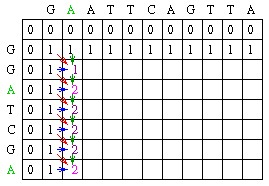In mathematics and computer science, dynamic programming is a method for solving complex problems by breaking them down into simpler steps. It is applicable to problems exhibiting the properties of overlapping subproblems which are only slightly smaller[1] and optimal substructure (described below). When applicable, the method takes far less time than naïve methods.
Top-down dynamic programming simply means storing the results of certain calculations, which are later used again since the completed calculation is a sub-problem of a larger calculation. Bottom-up dynamic programming involves formulating a complex calculation as a recursive series of simpler calculations.
In biological sequence analysis, dynamic programming is often used for sequence alignment using global sequence alignment(Needleman and Wunsch method).
Here I present a simplest interpretation of dynamic programming for aligning two sequences using global alignment(N&W method).
We have sequence 1: G A A T T C A G T T A
sequence 2: G G A T C G A
Here;
Length(seq1) = 11 and Length(seq2) = 7; lets call them k and l
In order to align them globally using dynamic programming method, we have to do the following;
1. Build a matrix M of size (k+1) X (l+1), putting seq1 in columns and seq2 in columns
2. Initialize the matrix where M[0,0..k] and M[0..l,0] is initialized into zero[Fig -1].

Fig - 1
The rest of the rows and columns can be filled using the following mathematical notation:
Mi,j = MAXIMUM[
Mi-1, j-1 + Si,j (match/mismatch in the diagonal),
Mi,j-1 + w (gap in sequence #1),
Mi-1,j + w (gap in sequence #2)]where Si,j is 1 for a match and 0 for a mismatch
w = 0
Now, lets talk about filling M(1,1) = MAX[ {M(0,0) + S(1,1)}, {M(1,0) + W}, {M(0,1) + W} ] = MAX[ {0 + 1}, {0 + 0}, {0+0} ]= 1
Going by this trend, M[1,2] is going to be: Max[{1+0},{0+0},{0+0} ] = 1So, we can start filling in the matrix this way:
From this, a common observation can be drawn:
1. Increment by one the value of a cell only when there is a perfect match to
that of the previous diagonal.
2. If there is a mismatch always continue with the value from the previous column/row.
Going by this, we can end up filling the matrix with the following values:
Now the last phase in dynamic programming:
3) Tracing back
Tracing back almost always begins with the highest score and looks to the diagonal up or to the left(gap in sequence-1) or up (gap in seq -2)
This tracing gives an alignment:
G A A T T C A G T T A
| | | | | |
G G A T - C - G - - A
OR
G - A A T T C A G T T A
| | | | | |
G G A - - T C - G - - A
For longer sequences large number of other combination is possible, but the dynamic programming outputs only one result.
[Ref: Images adapted from Eric C. Rouchka's web page]
In real life examples, different penalty scores are given for a mismatch and for a gap[Every time, you go down the columns or on a row without a match should be given a penalty as a gap]










No comments:
Post a Comment